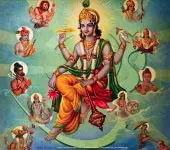Yudhishtira's Questions To Bheeshma
Bhagawan’s form was revealed to Arjuna as Vishwaroopa. Had Arjuna not been speechless then, he would have described him with these thousand names. But he couldn’t. He was awestruck and dumbstruck.
Bhagawan, out of his kindness, thought, let all my devotees have a glimpse of my Vishwaroopa — not just Arjuna — through my thousand names. He made Bhishma narrate them later to Yudhishthira. That is Sahasranama. So that the devotee can get a glimpse of what Arjuna saw.
You get to see everything that Bhagawan Vishnu is — in Sahasranama.
All that is there in the Geeta is also there in Sahasranama.
All that is there in the Upanishads is there in Sahasranama.
All that is there in the Vedas is there in Sahasranama.
The complete knowledge contained in the Vedas, travelling through the path called Upanishads and entering through the gate called Geeta, is placed before the devotee in the form of the thousand names — Sahasranama — as a simple and easy way to realize him.
Goswami Tulasidas says the name is greater than the Lord himself. Only people of Ayodhya benefited because of Sree Rama. But the whole world benefits from his name, by taking his name.
सर्वाण्येतानि नामानि परस्य ब्रह्मणो हरेः
एवमेतानि नामानि देवदेवस्य कीर्तयेत्
All these names are of Parabrahma Paramatma. Keeping this in mind, they should be chanted.
Yudhishthira asks six questions to Bhishma Pitamaha and he replies to them with a single answer, a single solution to all of them — which is Vishnu Sahasranama.
This event is at the end of a long question-answer session between Yudhishthira and Bhishma over the various aspects of dharma — righteousness, what is right, what is wrong.
वैशम्पायन उवाच –
श्रुत्वा…………..
Vaisampayana is the narrator of the Mahabharata and he is narrating it to King Janamejaya during the sarpa yajna Janamejaya conducted.
Vaisampayana is telling Janamejaya — धर्मान् पावनानि च सर्वशः अशेषेण श्रुत्वा — dharman —
अभ्युदय निःश्रेयसोत्पत्तिहेतुभूतान् — righteousness which gives rise to abhyudaya (welfare, happiness in this world) and nihshreyasa (the ultimate auspiciousness, enlightenment, moksha).
The dharmas are of two kinds — social (how one should conduct oneself in society) and spiritual (how one should conduct oneself to attain the goals — heaven or moksha).
पावनानि — पावनं jalam — those acts, those practices such as dana, tapas, japa which purify, like how water purifies and cleans.
Having heard all about dharma and the acts that purify — sarvashaha — his sources are many: Bhishma and all the great rishis who have assembled by the side of the shara shayya. And they are not just giving their opinions — they are quoting from other sources, from conversations and discussions and events that took place elsewhere and at different times. So Yudhishthira’s sources are multiple.
After that, Yudhishthira asked Shantanava — son of Shantanu — अभ्यभाषत.
Even after having heard and understood all about dharma, Yudhishthira could not find a single solution — that one method with which all the four purusharthas — dharma, artha, kama and moksha — can be achieved, in a simple and easy way. So he is asking Bhishma.
